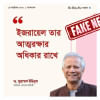Fact-checking: A pressing necessity in Bangladesh

Misinformation is a global phenomenon, but in countries like Bangladesh—where reliance on social media for information is high and fact-checking organisations are scarce—false information can spread rapidly, often with severe consequences. In such circumstances, media outlets should serve as pillars of trust for the public. Unfortunately, that has not fully been the case, particularly for certain sections of the media. All too often, they disseminate news without thorough verification.
During the heightened tensions leading up to the January 7 election, on October 28 of the previous year, some media outlets reported that Mian Arif, an advisor to US President Joe Biden, had visited the opposition BNP's central office following the suspension of their grand rally. However, the US Embassy in Dhaka later clarified that Mian Arif was not a representative of the US government. Similarly, on May 15, when the nation was gripped by fear over the devastation caused by Cyclone Mocha, several media outlets published false reports of multiple deaths on Saint Martin's Island in both online and print versions. The media's frequent issuance of false death announcements of public figures and pairing unrelated images with news stories are additional recurring problems.
Fact-checking organisation Rumor Scanner Bangladesh reviewed 681 reports across 164 media outlets and identified 78 false reports in the first half of 2024 (January to June). Previously, in the last half of 2023, they flagged 118 instances of misinformation in the media. In the first six months of 2023, they identified inaccuracies in 1,427 reports published by Bangladeshi media outlets. Another fact-checking platform, BOOM Bangladesh, noted an alarming rise in fake news stories published by mainstream media in 2023 compared to prior years.
This trend is deeply concerning. However, many media outlets still strive to maintain objectivity and publish news only after thorough verification. These responsible outlets, however, face a growing challenge: the rise of fake photo cards imitating the styles of established media to spread misinformation.
As a result, not only do media organisations find themselves in embarrassing situations, but discerning readers who rely on credible outlets are also misled. Even more troubling is the significant rise in misinformation involving media following the public uprising on August 5. Rumor Scanner reported 145 instances of fake photo cards, fabricated headlines, and counterfeit logos mimicking media outlets in 2023. By the first nine months of 2024, this number had risen to 324—more than double the previous year's figure. By closely mimicking the visual styles of leading outlets like Prothom Alo, Jamuna TV, and The Daily Star, many fake posts successfully deceived audiences.
In this context, fact-checking has become essential for both social media users and media organisations.
Media outlets are expected to uphold the highest standards of responsibility. A significant weakness of Bangladeshi media is their reliance on secondary sources without direct verification or cross-checking. This practice, particularly when citing unreliable international media, increases the risk of inaccuracies. For instance, reports on Middle Eastern events are often based on Indian media sources rather than verified through primary sources. Similarly, findings from scientific research are sometimes taken from secondary reports in Indian media instead of directly referencing original journals or research sites. This neglect of primary sources significantly heightens the likelihood of errors. To address this, media outlets must prioritise sourcing information directly from primary sources.
Moreover, many outlets now base news on social media posts by public figures, a practice that is far from ideal and highly prone to errors. Outdated images misrepresented as current can also contribute to misinformation but can be avoided through reverse image searches to verify authenticity and context.
The most pressing need is for mainstream media to establish dedicated fact-checking teams. Unfortunately, this remains rare in Bangladeshi media. While leading media organisations in developed countries actively maintain such teams, similar initiatives are almost non-existent in Bangladesh. The country's leading outlets—those with the necessary resources—should urgently launch these units.
Smaller outlets, unable to establish dedicated teams, can adopt interim measures like rigorous cross-checking, raising awareness, and collaborating with independent fact-checking platforms such as Rumor Scanner, AFP Fact Check, BOOM Bangladesh, BDFactCheck, Jachai, and FactWatch.
In the age of AI-generated content, verifying information has become even more challenging. Media organisations must integrate advanced AI tools to detect deepfakes and other forms of AI-generated misinformation.
Readers also play a crucial role in curbing misinformation. Before sharing news or photo cards seen on social media, readers should verify their authenticity. If the source is known for frequent inaccuracies, cross-checking with credible outlets is essential.
For photo cards allegedly from established media, examining details like spelling errors, logos, and content discrepancies can help identify fakes. In ambiguous cases, readers should refer to the official website or verified social media accounts of the concerned media outlet for confirmation.
By adopting such measures, both media organisations and readers can significantly curb the spread of misinformation in today's information-saturated world.
Zareen Tasnim is a sub-editor at The Daily Star.
Follow The Daily Star Opinion on Facebook for the latest opinions, commentaries and analyses by experts and professionals. To contribute your article or letter to The Daily Star Opinion, see our guidelines for submission.

 For all latest news, follow The Daily Star's Google News channel.
For all latest news, follow The Daily Star's Google News channel. 








Comments